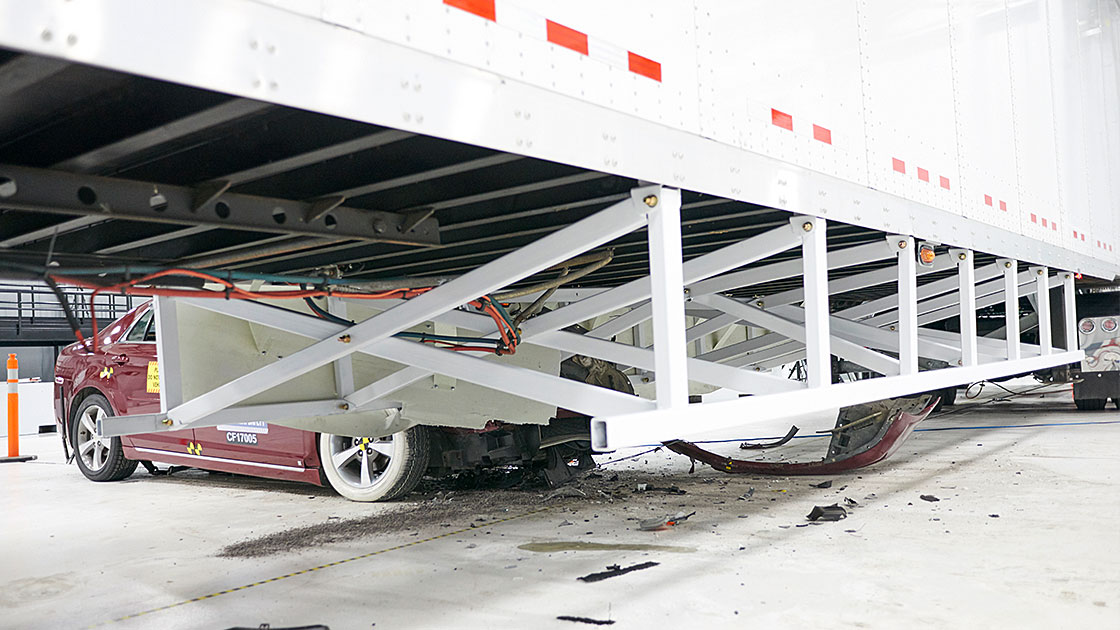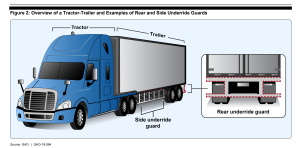NHTSA Begins Rule-Making Process for Side Underride Guards

Maximizing safety benefits of side underride guards can enhance overall road safety for passenger vehicles.
The National Highway Traffic Safety Administration (NHTSA) has recently started the rule-making process on NHTSA side underride guards for trailers. This follows a March 2019 Government Accountability Office recommendation and the November 2021 Infrastructure Investment and Jobs Act, which required the Department of Transportation (DOT) to research NHTSA side underride guards, report its findings, and seek public comment.
An increase in fatalities related to side underride accidents has prompted this review. After analyzing police reports, NHTSA concluded that there are 78 percent more fatalities associated with side underride than reported in the Fatality Analysis Reporting System (FARS).
Key points to consider in NHTSA’s review of side underride guards:
- Cost-benefit analysis of side underride guards
- Challenges faced by the trucking industry
- Implications for road safety
- Exploring advancements in technology
- Stakeholder collaboration for effective regulations
- Addressing concerns of all involved parties
- Maximizing safety benefits of side underride guards
- Enhancing overall road safety for passenger vehicles
“NHTSA’s latest research once again indicates there is absolutely no reason to mandate side underride guards on commercial trucks.” – Todd Spencer, OOIDA President
Enjoying our insights?
Subscribe to our newsletter to keep up with the latest industry trends and developments.
Stay Informed
Understanding Side Underride Guards and Current Regulations
Side underride guards are designed to prevent a passenger vehicle involved in a crash with a large truck or trailer from sliding underneath. Currently, no federal requirements for side guards on trailers exist in the U.S. However, cities like Boston, Chicago, New York, Philadelphia, Seattle, and San Francisco require side underride guards on city-owned truck fleets.
NHTSA’s Cost-Benefit Analysis of Side Underride Guards

The NHTSA has recently started the rule-making process on NHTSA side underride guards for trailers
The NHTSA has conducted extensive research to assess the potential benefits and drawbacks of implementing side underride guards on trailers. According to their analysis, 17.2 lives could be saved, and 69 serious injuries could be prevented annually if all trailers were equipped with side underride guards. However, the agency acknowledges that there are several factors that could significantly impact these calculations.
The Estimated Cost of Installing Side Underride Guards
NHTSA’s analysis is based on the AngelWing guard by AirFlow Deflector, which estimates the average total cost of installing side underride guards on a trailer at $2,990 in 2020 dollars. Adding incremental fuel costs due to the additional weight, NHTSA’s final estimate of the cost per trailer ranges between $3,740 and $4,630.
The NHTSA has estimated that the total annual initial cost of outfitting approximately 260,000 new trailers with side underride guards would be about $778 million. This figure does not account for additional costs associated with factors such as extra weight, reinforcing trailers to accommodate the guards, and changes to trailer loading patterns.
What Does the NHTSA Want to Know?
The agency is asking for information on other side underride guards available in the U.S. and more information on factors not included in its cost-benefit analysis, such as:
- Effects of side underride guards on trailer operations
- Additional wear and tear on equipped trailers
- Potential obstruction of proper safety inspections
- Possible impact on port and loading dock operations
- Cost and weight of strengthening the beams, frame rails, and floor of the trailer
Opposition to Side Underride Guard Mandate
The Owner-Operator Independent Drivers Association (OOIDA) opposes a side underride guard mandate, citing NHTSA’s research as evidence that the cost of a mandate would outweigh the benefits. OOIDA President Todd Spencer criticized the new Advisory Committee on Underride Protection, which will make recommendations to the Secretary of Transportation on safety regulations related to underride crashes.
Underride Advisory Committee Members
NHTSA announced the committee members, selected for their expertise, training, or experience in trucking and transportation safety areas, as well as law enforcement. The committee includes representatives from families of underride crash victims, truck safety organizations, motor vehicle crash investigators, law enforcement, labor organizations, motor vehicle engineers, the insurance industry, motor carriers, and truck and trailer manufacturers.
Public Comment Period and Next Steps
Comments on the advance notice of proposed rule-making close 60 days after publication in the Federal Register. To view the full ANPRM and to comment, visit www.regulations.gov; the docket number is NHTSA-2023-0012.
Implications of NHTSA Side Underride Guards Regulations
Should the NHTSA move forward with mandating side underride guards for trailers, it could have significant implications for the trucking industry. These potential effects include:
- Increased upfront costs for trailer manufacturers and trucking companies
- Additional fuel costs due to increased weight
- Changes in trailer loading patterns and operations
- Possible impact on trailer lifespan and maintenance requirements
Importance of Side Underride Guard Regulations for Road Safety
While the NHTSA’s cost-benefit analysis has raised concerns among some stakeholders, it is essential to consider the potential benefits of implementing side underride guards. These benefits include:
- Saving lives and preventing serious injuries
- Enhancing overall road safety for passenger vehicles
- Aligning U.S. regulations with international standards for lateral protection devices
Possible Future Developments in Side Underride Guard Technology

Advancements in technology can play a vital role in the development and implementation of side underride guards.
As the NHTSA seeks more information on alternative side underride guards available in the U.S., it is possible that new technologies and designs may emerge to address some of the concerns raised during the rule-making process. Potential advancements in side underride guard technology could include:
- Lightweight materials to reduce additional weight and fuel consumption
- Improved designs to minimize wear and tear on trailers
- Enhanced integration with existing trailer structures for easier inspections and maintenance
Stakeholders Collaboration for Effective Regulations
It is crucial for the NHTSA, trucking industry stakeholders, safety organizations, and the public to collaborate in developing effective regulations for side underride guards. By working together, these parties can ensure that any potential mandate addresses the concerns of all involved while maximizing the safety benefits of side underride guards.
Conclusion: Balancing Costs and Benefits of NHTSA Side Underride Guards
The NHTSA’s review of side underride guards for trailers has sparked a debate on the costs and benefits of implementing such regulations. While the agency’s cost-benefit analysis has raised concerns, it is essential to consider the potential benefits of side underride guards for road safety. By engaging with stakeholders and exploring advancements in technology, the NHTSA can develop effective regulations that balance costs and benefits, ultimately enhancing safety on U.S. roadways.
“Maximizing safety benefits of side underride guards can enhance overall road safety for passenger vehicles.”
“Advancements in technology can play a vital role in the development and implementation of side underride guards.”
More information on Side Underride Guards:
- Cities with side underride guard requirements for city-owned truck fleets:
- Boston, Chicago, New York, Philadelphia, Seattle, and San Francisco.
- Initiating factors:
- Government Accountability Office recommendation (March 2019) and the Infrastructure Investment and Jobs Act (November 2021).
- AngelWing guard details:
- Tested by the Insurance Institute for Highway Safety in 2017; cost and weight estimates based on this guard ($2,990 per trailer for installation and additional fuel costs; 450 to 800 pounds in weight).
- Advisory Committee on Underride Protection members:
- Marianne Karth and Jane Mathis to represent families of underride crash victims.
- Harry Adler and Jennifer Tierney to represent truck safety organizations.
- Lee Jackson and Aaron Kiefer to represent motor vehicle crash investigators.
- Adrienne Gildea to represent law enforcement.
- Daniel McKisson to represent labor organizations.
- Jeff Bennett and Jeff Zawacki to represent motor vehicle engineers.
- Matthew Brumbelow and Claire Mules to represent the insurance industry.
- Dan Horvath and Doug Smith to represent motor carriers, including independent owner-operators.
- John Freiler and Kristin Glazner to represent truck and trailer manufacturers.
To view the full ANPRM and comment, visit www.regulations.gov; the docket number is NHTSA-2023-0012.
Dive Deeper into Related Topics:
- For the latest updates on NHTSA’s initiatives and policies, click here.
- Stay informed on the impact of highway safety efforts and improvements by visiting this link.
- Discover more about the various regulations affecting the trucking industry by exploring this page.
Explore Industry Resources and Insights:
- Government Accountability Office Report on Truck Underride Guards
- Department of Transportation’s Analysis of Side Underride Guards
- Understanding Underride Protections: The Truck Safety Coalition’s Perspective
For more information on original article visit HDT Trucking Info






















